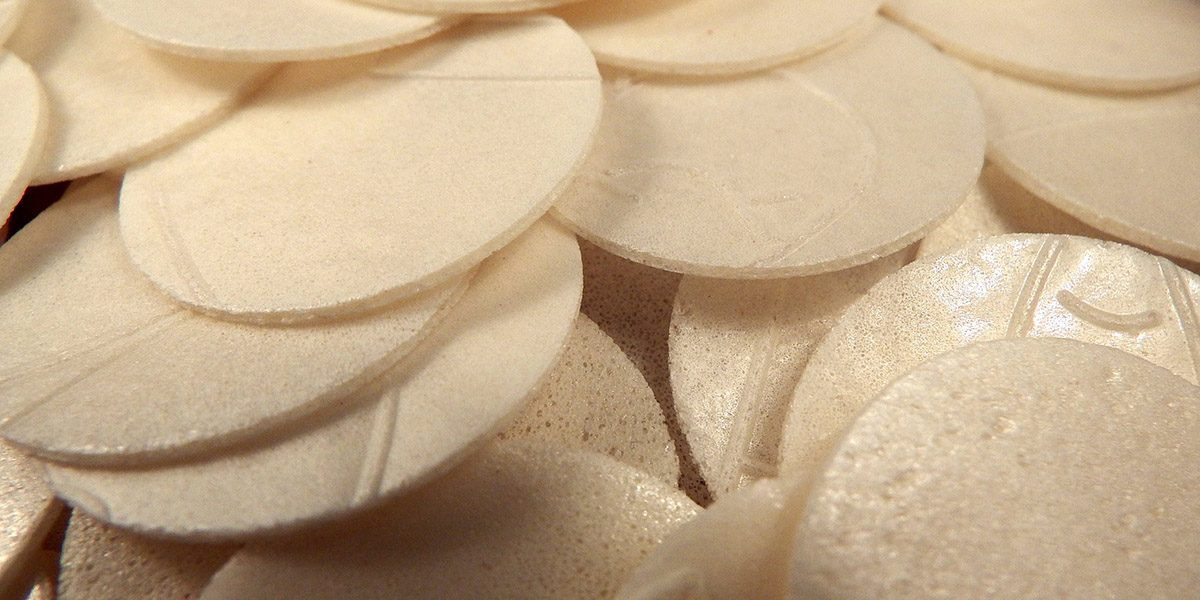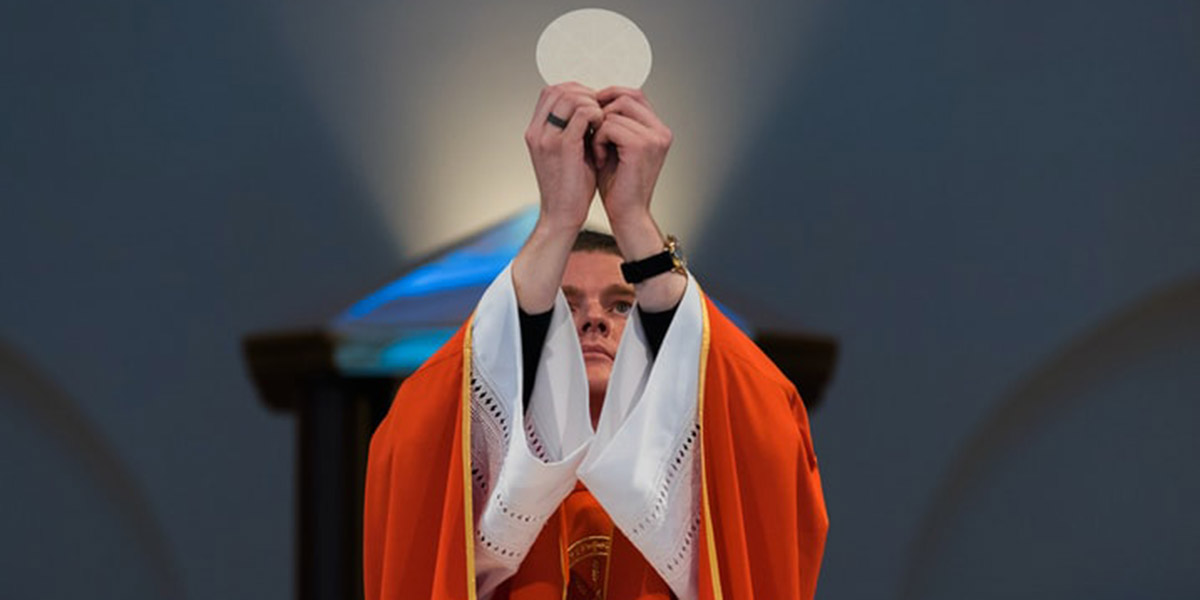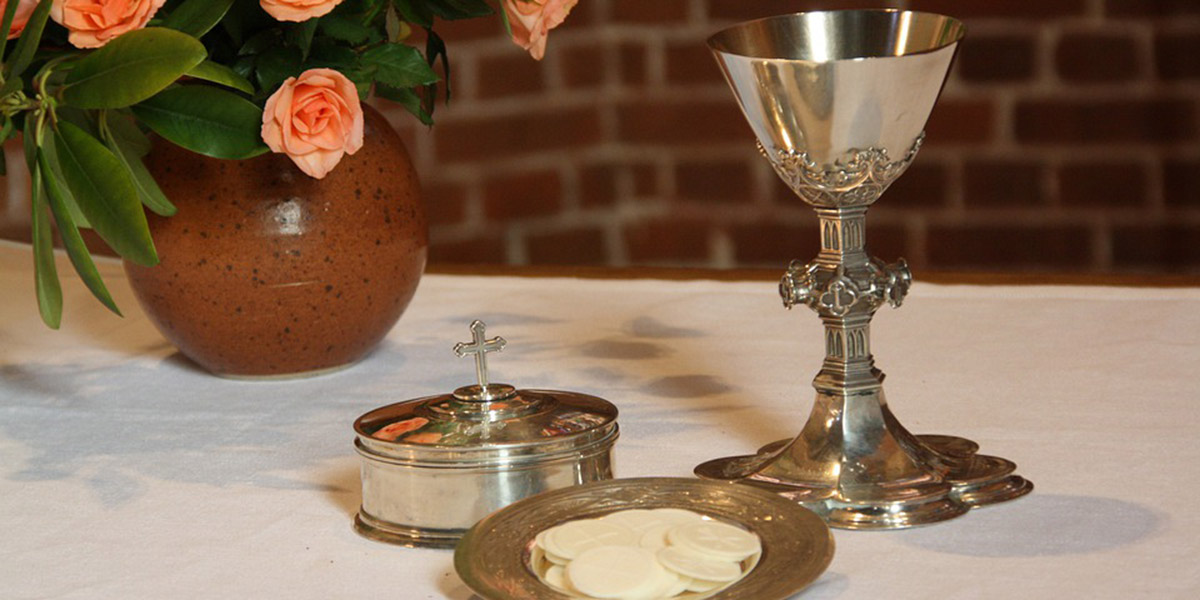Regina Caeli – Queen of Heaven, Rejoice!
The Regina Caeli, Latin for “Queen of Heaven,” is a hymn and prayer ...

Getting More out of the Mass – practical tips on entering more deeply into the Eucharist and unlocking its spiritual power in our lives.
Everyone knows that the Catholic Church believes in “real presence” of Christ in the Eucharist. The bread and wine offered by the priest is not just a symbolic reminder of Jesus and what he did for us 2,000 years ago. No, the Church teaches that these elements actually become the body and blood of Jesus Christ, the Son of the Living God. But if the power that moves mountains, raised Lazarus from the dead, and created heaven and earth is present in the liturgy, shouldn’t Mass-goers be experiencing more changes in their lives?
A Gallup poll done a few years back demonstrated that the majority of those who attend Mass more than occasionally exhibit exactly the same lifestyle and values as those who don’t attend Church at all. Some could conclude from this that Catholic teaching about “the real presence” must be wrong. But there are two sides to church teaching on the Mass, and both must be noted in order to answer the question.
On the one hand, Christ is truly present in the Eucharist. He’s among us as truly as he was among the crowds during his public ministry. On the other hand, the results produced in our lives from our encounter with the Lord will be directly proportional to our faith and openness. This explains why so few people appear to be changed by their encounter with Christ in the Eucharist.
Faith makes all the Difference
Actually, the impact of Jesus’ bodily presence today in the Eucharist is much the same as it was in the days of his public ministry. Think about the crowd that Jesus was walking through the time he whirled around and said, “Who touched me?” (Mk 6:24-34). The apostles were puzzled. “What do you mean, Lord? You just bumped into a hundred people.” But Jesus meant, “Who reached out and touched me with faith?” Then the woman with the hemorrhage came forward. Out of the multitude who had touched Jesus physically, she was the only one healed. No one else recognized who Jesus was; they expected nothing, and they got nothing. Her faith, on the other hand, established the connection that allowed Christ’s healing power to flow into her. Her faith made all the difference.
The others who got nothing out of their encounter with Jesus remind me of the soil in the oppressive Texas summers. Beginning in May, we have day after day of non-stop sun. By mid-June the ground is baked as hard as clay pottery. As a result, whenever we do get the occasional summer downpour, we have flash floods. The water can’t soak in and become available to the thirsty plants because the ground hasn’t been prepared. The life-giving water just runs off.
That’s what happens with many of us at Mass. The life-changing power of grace is available, but it can’t penetrate. We’re not ready. Our hearts are hard and haven’t been broken up through prayer, faith, and fasting.
With this in mind, I offer here a few specific strategies to get us ready and make the Eucharist a more fruitful experience, regardless of any shortcomings of the priest, choir, and congregation.
Preparing by fasting. The church has a discipline of a Eucharistic fast. For Roman rite Catholics, this means an obligation to abstain from all food and any drink but water for one hour prior to receiving Communion. This minimal requirement reminds us that we must prepare ourselves to receive the Lord in the Eucharist.
Certainly, we’re free to do more. For example, how about fasting from noise and media-generated distractions? It’s a good idea to leave the radio and TV off, the newspaper unopened, and the computer idle for an hour or more before Mass. That way, our minds are freer of noise and clutter, and we don’t have to fight so hard to be able to concentrate on the Lord when we walk into Mass.
Pondering the readings. We can prepare for Mass by looking over the readings ahead of time. This gives us a head start in understanding them before we hear them read aloud in church. Our Sunday Visitor’s weekly column, “The Double-Edged Sword” is a good way to help understand these readings and apply them to our life.

Above image by Josh Applegate on Unsplash. Public domain.
Pre-prayer. The church has always recommended that we prepare for Mass through prayer. One practical suggestion is to get to Church a little early. Even five minutes can give you time to dial down, unwind, and focus before Mass begins.
Whenever I get to church early enough for this prayer time, I concentrate on arousing my faith. I make conscious acts of faith about Christ’s real presence in the various aspects of the liturgy. My prayer might go something like this: “Lord, I see these folks around me. Some of them are distracted; some are people I don’t necessarily like, on a human level. But I really believe that these are your brothers and sisters, and therefore mine. Together, we are one body in you. I honor you here. Lord, I believe that today’s presider is really acting in your place and that you’re exercising your priesthood through him. Bless him and anoint his preaching today. Help him to participate fully in this Eucharist. Lord, I believe you’re going to be present in the word. Open my ears to hear you. I don’t want to be daydreaming about my to-do list and all the things I’ve left undone. Make it possible for me to focus—to hear and respond to you…. Finally, Lord, help me to welcome you as I receive your sacred Body and Blood and be changed by your presence.”
Making an “act of faith” like this is a way of exercising our faith muscles. It’s like working out. You really can’t grow your muscles unless you exercise them.
I have to admit that quiet, recollected time of prayer before the liturgy works best for me before weekday Mass, when I’m alone. On Sundays, when my wife and I attend Mass with our five children, it’s just not a possibility. But we do try to prepare as a family while driving to church. We sing a song, say a decade of the rosary and offer spontaneous prayers like, “Lord, help us to focus and concentrate at this Eucharist. We want to give ourselves to you.” I don’t want to give the impression that this works perfectly. Sometimes prayer is interrupted by exhortations to take off the headphones or turn off the Game-Boy! Still, we make the effort, and maybe half the time we actually succeed in having some recollected prayer. Even when it doesn’t work out, it teaches the children that Mass is important and requires preparation.
Dressing for the occasion. As a young adult, I often walked into church wearing cut-off jeans and tank top t-shirts. “What do my clothes matter?” I used to think. But then it occurred to me that perhaps they weren’t really appropriate, given the magnitude of the event. Without going out and buying a wardrobe of designer suits, I did start dressing more respectfully in honor of the occasion.
For sure, I’d never encourage anyone get into a competition about who’s best-dressed atMass. I do think it’s worth asking this question, though: Does the way I dress for Sunday Mass reflect my faith that I’m visiting Christ and that this is the central event of my week?
Deciding about the kids. Parents of young children should be relieved to know that there’s no law about coming to Mass as a family. You’re perfectly free to attend together or to split up, depending on what works best.
Sometimes, “divide and conquer” is the best strategy. When we had three kids under four, it was hopeless for all of us to go to the Sunday Eucharist together. Whenever we tried it, Susan and I ended up spending the entire time trying to keep the children from disturbing everyone else’s recollection, not to mention our own. For quite a while, we went to different Masses, one staying home with the kids while the other went to Church. Occasionally we got a friend or relative to babysit and went to Mass together.
The point is that parents have to exercise both flexibility and determination so that each one can prepare for Mass and experience it prayerfully. This can require a bit of creativity.

Above image by sabineoesterlin on Pixabay. Public domain.
Would it make sense to leap up from Thanksgiving dinner and go out and run a marathon? That’s a sure road to indigestion or worse! Neither should we run off from the Lord’s Table without giving ourselves an opportunity to digest what we’ve consumed.
The Eucharist is a lavish banquet, a Feast of Faith, and it takes some digestion and follow-up to really profit from it. Since it’s too rich for us to absorb all at once, the church encourages us to take some time to pray after Mass. As the Catechism points out, “prayer internalizes and assimilates the liturgy during and after its celebration” (par. 2655).
What better place to pray than the very church where you’ve just participated in the Mass? When you can, linger a little bit after the dismissal to be with the Lord and continue your thanksgiving after Communion. This isn’t just my idea; the church recommends it in an official document called “On Holy Communion and the Worship of the Eucharistic Mystery outside of Mass.” It reads: “In order to continue more surely in the thanksgiving that in the Mass is offered to God in an eminent way, those who have been nourished by Communion should be encouraged to remain for some time in prayer” (par. 25).
Social time with other members of the church is really important, too. Since we’re all members of Christ’s body, we should be getting to know one another and enjoying each other’s company either before or after Sunday Mass. But that’s not incompatible with taking a few minutes for personal prayer following the liturgy. It helps if the entire parish can make an agreement to keep the church quiet after Mass. Fellowship can begin outside the sanctuary—in the vestibule, church hall, or parking lot. I know of a Catholic university that adopted this approach, and it’s working beautifully. At the end of Mass, they turn the lights down low, and whoever needs to leave right away does so. Most kneel down to pray for a few minutes and then proceed outside for coffee, fun, and sharing.
Prayerful follow-up to the Mass can also take place later at home. This might happen individually, as we find bits of time for personal prayer, or as a family or other grouping of Catholics who have been to Mass that day. In my own family, we sometimes read the Scriptures for the day at dinnertime. Again, with young children present, it’s an imperfect experience. Sometimes the kids actually pay attention, and sometimes they’re a million miles away. But we’ve seen enough fruit from our successes that we find it’s worth the effort. And again, even our failures say something to the kids and to the Lord.
I was once comforted by a priest who told me that the attempt to pray is itself prayer. The attempt to love is itself love. I hang onto this thought whenever our family prayers seem less than spectacular. God honors our intentions and efforts.
“I’m not getting anything out of Mass.” Next time you hear someone say this—or fall into this way of thinking yourself—remember what the Church teaches about Christ’s real presence in the Eucharist. The good news is that he’s really there, no matter how lackluster the priest, the church, the music, and the liturgy may be. Nothing and no one can stop us from being in Jesus’ presence to receive him and give ourselves to him. The bad news is, if we don’t get anything out of Mass, there’s no one to blame but ourselves.
For more resources on the Mass, visit the EUCHARIST SECTION of the Crossroads Initiative LIBRARY.
Banner/featured image by David Eucaristia on Pexels. Public domain.
No Comments